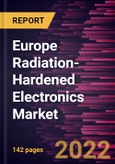The Europe radiation-hardened electronics market is expected to grow from US$ 457.71 million in 2021 to US$ 624.22 million by 2028; it is estimated to grow at a CAGR of 4.5% from 2021 to 2028.
Over the years, satellites have experienced high adoption across various industries such as communication, networking, television broadcast, and space-based surveillance. The satellites are prone to solar flares, which leads to system failures. This influences the adoption of radiation-hardened electronics across the end-use industries such as aerospace & defense, nuclear power plants, and space. Some major procurements of radiation-hardened electronics across the region have occurred in the past few years. For instance, the European Space Agency (ESA) granted CAES, a leader in advanced mission-critical electronics, a contract to create a fault- and radiation-tolerant system-on-chip in December 2021. The project, which the Swedish National Space Agency funds, will develop a 16-core, space-hardened microprocessor based on the open RISC-V instruction set architecture to improve performance and power efficiency in satellite and spacecraft applications (ISA). The rise in procurement of radiation-hardened electronics by various organizations is fueling the growth of the global radiation-hardened electronics market across the region.
With the new features and technologies, vendors can attract new customers and expand their footprints in emerging markets. This factor is likely to drive the Europe radiation-hardened electronics market . The Europe radiation-hardened electronics market is expected to grow at a good CAGR during the forecast period.
BAE Systems; Data Device Corporation; Honeywell International Inc.; Infineon Technologies AG; Microchip Technology Inc.; Renesas Electronics Corporation; STMicroelectronics; Texas Instruments Incorporated; VORAGO Technologies; and Xilinx, Inc. (AMD) are among the leading companies in the Europe radiation-hardened electronics market.
Over the years, satellites have experienced high adoption across various industries such as communication, networking, television broadcast, and space-based surveillance. The satellites are prone to solar flares, which leads to system failures. This influences the adoption of radiation-hardened electronics across the end-use industries such as aerospace & defense, nuclear power plants, and space. Some major procurements of radiation-hardened electronics across the region have occurred in the past few years. For instance, the European Space Agency (ESA) granted CAES, a leader in advanced mission-critical electronics, a contract to create a fault- and radiation-tolerant system-on-chip in December 2021. The project, which the Swedish National Space Agency funds, will develop a 16-core, space-hardened microprocessor based on the open RISC-V instruction set architecture to improve performance and power efficiency in satellite and spacecraft applications (ISA). The rise in procurement of radiation-hardened electronics by various organizations is fueling the growth of the global radiation-hardened electronics market across the region.
With the new features and technologies, vendors can attract new customers and expand their footprints in emerging markets. This factor is likely to drive the Europe radiation-hardened electronics market . The Europe radiation-hardened electronics market is expected to grow at a good CAGR during the forecast period.
Europe Radiation-Hardened Electronics Market Segmentation
The Europe radiation-hardened electronics market is segmented based on component, manufacturing technique, application, and country. Based on component, the market is segmented into power management components, analog and digital mixed signal devices, memory, and controllers & processors. The power management component segment dominated the market in 2021 and is expected to be the fastest-growing segment during the forecast period. Based on manufacturing technique, the market is segmented into radiation hardening by design (RHBD) and radiation hardening by process (RHBP). The radiation hardening by design (RHBD) segment dominated the market in 2021. It is anticipated to be the fastest-growing segment during the forecast period. Based on application, the market is segmented into aerospace & defense, nuclear power plant, space, and others. The space segment dominated the market in 2021, and the others segment is expected to be the fastest-growing segment during the forecast period. Based on country, the Europe radiation-hardened electronics market is segmented into France, Germany, Italy, the UK, Russia, and the Rest of Europe.BAE Systems; Data Device Corporation; Honeywell International Inc.; Infineon Technologies AG; Microchip Technology Inc.; Renesas Electronics Corporation; STMicroelectronics; Texas Instruments Incorporated; VORAGO Technologies; and Xilinx, Inc. (AMD) are among the leading companies in the Europe radiation-hardened electronics market.
Table of Contents
1. Introduction
3. Research Methodology
4. Europe Radiation-Hardened Electronics Market Landscape
5. Europe Radiation-Hardened Electronics Market - Key Market Dynamics
6. Radiation-Hardened Electronics Market - Europe Analysis
7. Europe Radiation-Hardened Electronics Market Analysis - By Component
8. Europe Radiation-Hardened Electronics Market Analysis - By Manufacturing Technique
9. Europe Radiation-Hardened Electronics Market Analysis - by Application
10. Europe Radiation-Hardened Electronics Market - Country Analysis
11. Industry Landscape
12. Company Profiles
13. Appendix
List of Figures
List of Tables
Companies Mentioned
- BAE Systems
- Data Device Corporation
- Honeywell International Inc.
- Infineon Technologies AG
- Microchip Technology Inc.
- Renesas Electronics Corporation
- STMicroelectronics
- Texas Instruments Incorporated
- VORAGO Technologies
- Xilinx, Inc. (AMD)
Table Information
| Report Attribute | Details |
|---|---|
| No. of Pages | 142 |
| Published | August 2022 |
| Forecast Period | 2022 - 2028 |
| Estimated Market Value ( USD | $ 457.71 Million |
| Forecasted Market Value ( USD | $ 624.22 Million |
| Compound Annual Growth Rate | 4.5% |
| Regions Covered | Europe |
| No. of Companies Mentioned | 10 |








